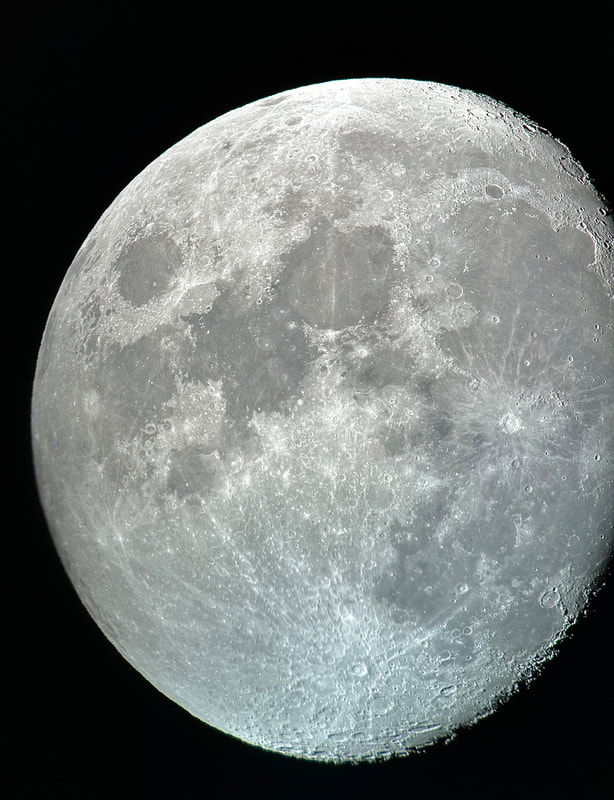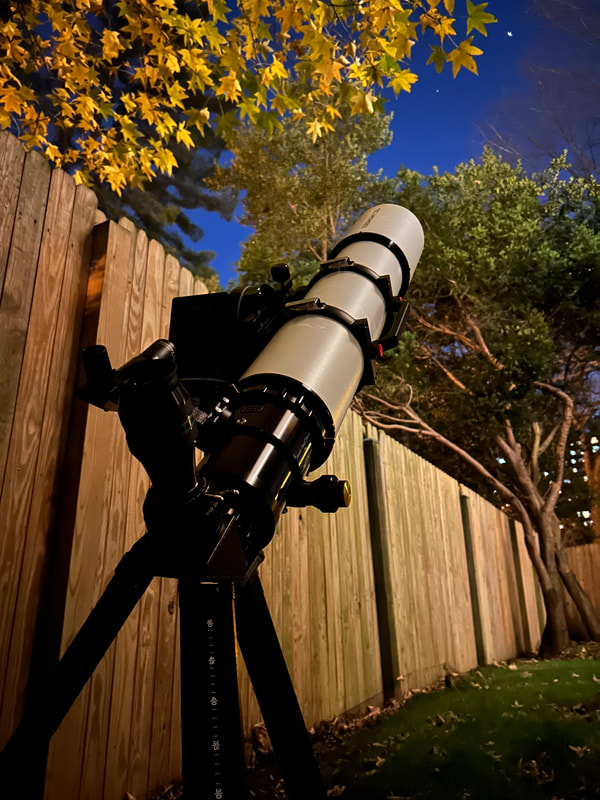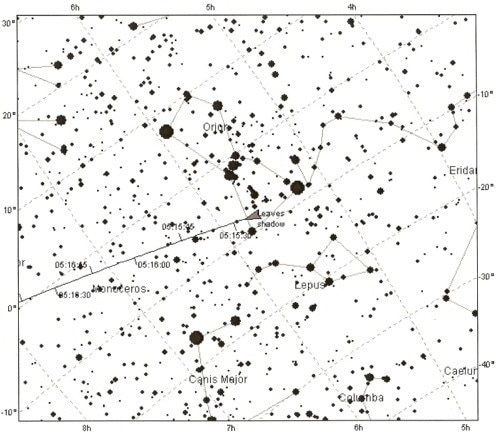|
Tonight was one of those relatively rare wintry nights in Washington, DC, where atmospheric transparency is high while seeing is better than average. With Mars just four days away from opposition - its biannual closest approach to Earth - I couldn't let the opportunity slip. The canopies above my backyard are now sufficiently denuded for me to use a telescope just a few steps from my door, so out I stepped with my TEC 140. The Moon was just about to slip behind my building, and I was hard pressed to get a quick picture. The view was in fact beautifully sharp, what you see above is the only shot I could get. I also managed to get a quick look at Jupiter, where to my surprise it seemed that one moon - near the limb of Jupiter - was far below the orbital plane set by the other moons. I don't think I've seen that before. Eventually, I found a comfortable nook from which to observe Mars. Seeing seemed a good deal better than average tonight, and the outline of the planet was about as sharp and steady as I've ever seen it. I was struck by how much smaller it seemed than it did during its last opposition, two years ago, when it looked only marginally smaller than it did during its perihelic opposition of 2018. Of course, my gear has improved since then, so the views of Mars I've had this year haven't been much worse than those I had in 2020. Still, the planet's apparent diameter is only about 17 arcseconds this year - down from 22.4 in 2020, and a whopping 24.2 in 2018. In fact, not since 2014 has Mars looked so unimposing at opposition.
More important for viewing Mars than the apparent size of the planet or my equipment, however, has been dust. In 2018, I couldn't make out any details on Mars while using my Skywatcher 100ED, and that owed more to a yellow, planet-wide dust storm than the lack of perfect color correction on the refractor. In 2020, Mars was relatively dust-free, and so a deeper shade of red. I was ready then with a pair of telescopes (my dearly departed APM 140 and Takahashi FC-100DC) that were only slightly less capable than those I own today. Now Mars seems dusty and a bit yellowish again, but not as much as it was in 2018. Surface detail has obvious through my TEC 140 and Takahashi FC-100DZ, though not as much as it was in 2020, and the planet's disk is comparatively small. I replaced my APM 140 with the TEC 140ED, and my FC-100DC with the FC100DZ, in large part to prepare for this year's opposition. I'm glad I did, but in making those replacements I've also come to realize that there really are rapidly diminishing returns for costly upgrades in this hobby. Yes, views through the DZ seem marginally better than the ones I enjoyed with my wonderful DC, but from night to night conditions in our atmosphere - and that of Mars - are much more important. Tonight I was again reminded of how trifling differences in performance between optics can be enormously exaggerated in online discussions. It's widely held that high-contrast eyepieces such as the TeleVue Delos will easily outperform zoom eyepieces, including the latest iteration of the Baader Hyperion Zoom. While switching between the zoom eyepiece and the Delos 4.5mm and 6mm eyepieces, however, I found that magnification affected the view far more than the eyepiece I was using. The view seemed just right at around 160x; any more than that, and it got a little blurry. Both the Baader and TeleVue eyepieces provided striking and at times rather complex views of Mare Cimmerium at that magnification, along with flashes of Trivium Charontis and perhaps some other dark regions in the northern hemisphere of Mars. I thought I might have caught some hints of white swaths far to the south, but they were hard to pin down; I fancied they might be clouds. I saw very little to separate the eyepieces, but I eventually found myself settling with the 6mm Delos because of its larger field of view. If pressed I might confess that dark albedo regions were more consistently obvious in the Delos than the Baader Zoom - but that may be only because I expected to see them more clearly in the Delos. One thing's for sure: I'll never again assume that I'm missing out by using the zoom eyepiece as opposed to a Delos, and I'll be a little more careful when reading claims that one premium eyepiece or telescope is clearly superior to another. I hope to have another chance to observe Mars this week, and certainly this month, but if not tonight was a wonderful way to mark the planet's opposition.
0 Comments
Leave a Reply. |
Archives
March 2024
Categories
All
|





 RSS Feed
RSS Feed